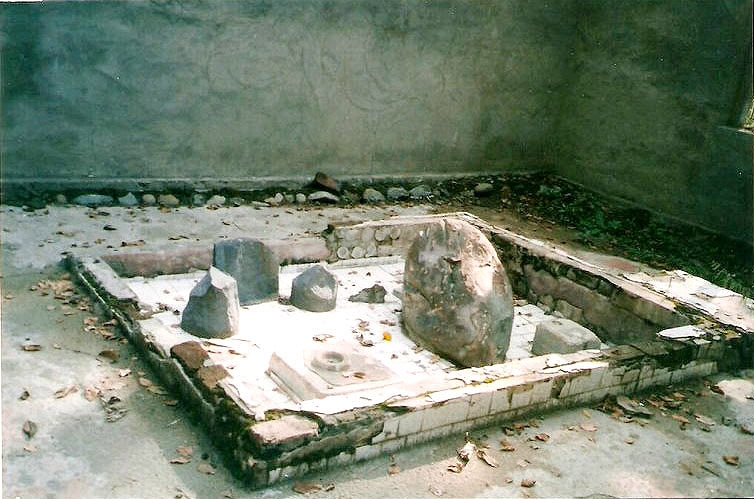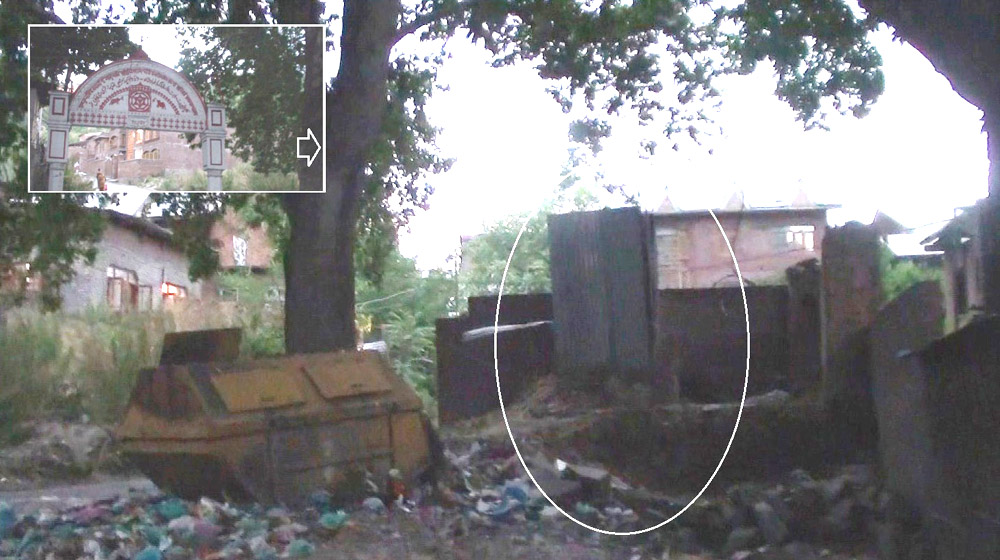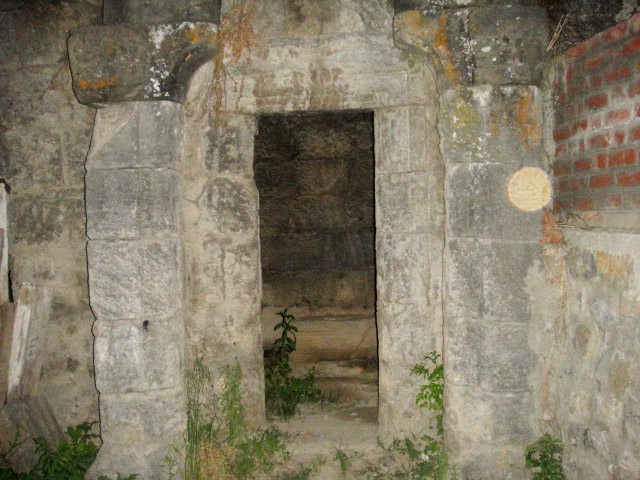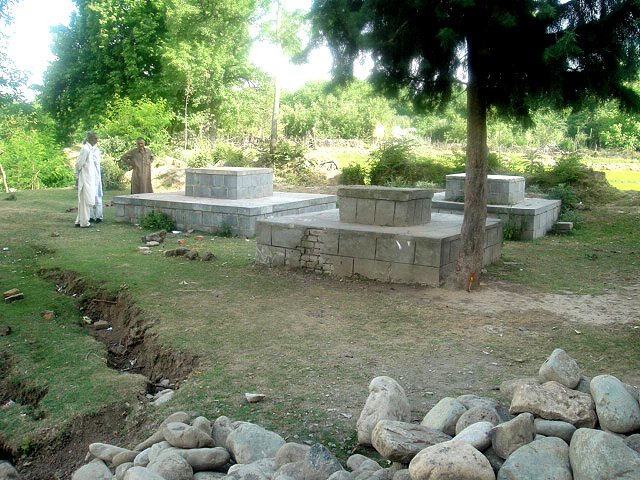Multi-fanged Encroachment
Of Hindu Temples and Shrines in Kashmir
Dr. R L Bhat

Gutted Temple at Kakran, Kashmir
Of Hindu Temples and Shrines in Kashmir
Dr. R L Bhat

Gutted Temple at Kakran, Kashmir
Chakrabrit-vijayash-aadi-keeshava-ishaana-bhuushitee |
Tila-ansh api na yatra asti prithvyah tiirthah bahishkritah ||
(Raj Tarangini, Bk.1 sh: 38)
Pandit
Kalhana’s assertion that not even a speck of Kashmir’s land is free of
tiirthaas is shown to be literally true, as we survey the spread of
Shrines, temples, asthaapans and tiirthaas of Kashmir, seven centuries
later. The centuries following Kalhana saw large scale demolition and
usurpation of temples and shrines, encroachment upon their lands and
decimation of the culturo-ethnic symbols of Kashmir. That same process
was repeated during the past twenty years, as Kashmir came under the
sway of fundamentalists. As per the report on temples complied by the
Divisional Commissioner, Kashmir in 2005, for the Inter-ministerial
Committee appointed by the Government Of India, over 40% of the Hindu
Shrines and Temples in Kashmir valley were destroyed completely during
this fundamentalist surge. Yet this is only half the story as the report
was limited to the counting number of temples destroyed. As it is,
there has been large scale undermining of the Hindu shrines,
encroachment on the religious lands, usurpation of the shrine properties
and wholesale decimation of the Hindu cultural and religious symbols in
Kashmir during the last twenty years. This destruction has taken place
all over the valley from the Northern-most parts in Kupwara district to
southernmost tips in Kulgam district. The picture above is the actual
photograph of sanctum sanctorum of the Kulvaagishori temple in Kulgam
town which I took in 2001. It tells how callous this invasion of the
temples has been. In fact, the vandalism has been so thorough and so
widespread that it is not possible to recount it all even if this
session today is devoted to this discussion only. We, therefore purpose
to discuss it under the broad categories of damage/destruction inflicted
upon the Hindu Shrines and temples of Kashmir. These categories are:
First the Outright Destruction, when rioting mobs burnt them and razed
them down. Second, Individual Encroachment upon lands, third is Public
Encroachment, fourth is Loss Due To Neglect and fifth is the Usurpation
and Encroachment by Government.Tila-ansh api na yatra asti prithvyah tiirthah bahishkritah ||
(Raj Tarangini, Bk.1 sh: 38)
1. Outright Destruction Of Temples:
This was the first onslaught on the temples most of which took place in 1990, 1991, 1992. As per the Divisional Commissioner, Kashmir’s report cited above,
- 13 Temples were destroyed fully in district Kupwara,
- 27 in Baramullah,
- 8 in Budgam,
- 18 in Srinagar district,
- 48 in Pulwama district and
- 57 Temples in Anantnag district.
 Kulvaagishori temple ruins 2001 |
||
2. Individual Encroachment of shrine lands
This is the second aspect of this vandalisation which has not been fully known to all. The shrine lands after the destruction of the temples were exposed to general abuse. A pathetic case is the ancient Shiva temple at the ddyooddii of Sharika Bhagwati near Tibetan colony in Srinagar. The temple was destroyed. The land has been appropriated by the residents, one of whom has walled in part of the temple. The sacred temple space, thus thrown open is being used as a Municipal dumping ground with two large iron refuse-bins positioned upon it. The helpless local Hindus have now covered the exposed holy Linga with 8-iron sheets on four sides. The site, left in decay and degradation, has become a sleeping space for stray dogs.
Another glaring case of encroachment is the Diivii Aangan at the Haari Parvat just on the other side of the ddyooddii, on left side of road the leading to the Haari Parbat Shrine. Over a dozen kanals of shrine land, which was used for havans, has been occupied. A huge private school building stands upon it. Here one must admit that the stand-off between the two management committees of the shrine is not helping the matters. But then, the continued inaction of the government both on this encroachment on Diivii Aangan as well as the ddyooddii temple is pathological. For the last fifteen years the local Hindus have been struggling to get land freed. Here I have been asked to specifically mention the action taken by tehsildar Doru, One Mr. Hajam in recovering the crop-share of Gosain Gund Ashram lands from the tenants of the Ashram land, but the same cannot be said of the revenue administration in other place. In Tral, district Pulwama, the due crop-share of Buutshuu Asthaapan in Zachikhav lands has been appropriated by the tenants all these years. Likewise, due the crop-share due to the Lav Naag Asthaapan of Lalpora distt. Kupwara from 182 kanals of the shrine lands has not been recovered from the tenants. The temple lands of Sonda Braarii in Anantnag have also been occupied. In fact the shrine lands, all over the valley, are in varying degrees of encroachment and occupation by individuals. In Budgam district, we come across an usurpation of a different type. The famous Abhinav Gupt Cave at the Baa’rav tteng, at Biirvah in Badgaam district, is under an unholy threat due to the stone-quarrying begun on a large scale. The historical gufaa is in great danger and may become actually extinct if the indiscriminate quarrying at Baa'rav tteng is not stopped immediately.
 Ddyuuddii temple Hari Parbhat_BRIGHT_inset |
||
In this category are generally the cremation grounds and open religious lands of Hindus. The Divisional Commissioner, Kashmir’s report cited above mentions 29 localities in Srinagar and 306 different village and town localities with temples. A survey and listing of the shrines and temples has been undertaken by us, which shall be published on the 27th Dec, Cheetna Divas, the anniversary of martyrdom of Prem Nath Bhat. The survey lists over 400 Hindu locations in the valley. All these were Hindu habitations and had cremation grounds duly listed in the revenue records. Except some cases which we shall deal with separately, most of these cremation grounds have been usurped/encroached upon by the people. The trees standing there upon have been cut down. Houses have come up at some places; other places have been put to commercial use by people. The Hindus hailing from these places have brought the abuse of shamshaan ghaatts to the notice of the concerned authorities but action has been rare, even though the Deputy Commissioners as the custodian the properties under the Prevention of Distress sale of Properties (Migrants), Act of the J&K Assembly are bounden to ensure that this abuse does not take place. For example, the 25 canal cremation ground of at Safapore on the bank of Manasbal lake in Ganderbal district is under varying types of occupation. Similarly, the huge grounds in Haa’rii Paa’rii gaam at the foot hills along with the holy spring there have been usurped by the people for communal use. Here one may be allowed to cite a comparative example, from Kathua district of Jammu Division. A hospital building being constructed at Hatli village at a cost of 38 lakhs under NABARD was got stopped by D.C., Kathua on a simple application alleging that the land was Kabristaan, a Muslim graveyard. A survey of the land was made, the Kabristaan land were demarcated and only after the allegation against the hospital had been proved to be baseless, was the construction allowed to resume. such action rarely takes place in Kashmir, even though the D.C’s are bounden by law to do it. It may be noted here that the cremation grounds at the 400 and odd Hindu habitations in Kashmir referred to above, comprise lands from 10-30 kanals of land. The Shamshaan ghaatts in about 50-60 villages extended to less than 10 kanals and in only a few cases was it the lowest 2-3 kanals. We, therefore, are talking here of public encroachment of thousands of Kanals of religious lands of Hindus. It would be 8,000-10,000 kanals at a conservation estimate. All these lands have been usurped in violation of the rights and religious sentiments of the displaced Hindus.
A distinct type of shamshaan ghaatts are the shishu samaadhiis. As is well known, Hindus do not cremate the dead infants but bury them. These, shishu samaadiis existed in all cities, towns and major villages. The minimal number of shishu samaadhiis in the valley as distinct and separate from the cremation grounds, can be put at around 200. The shishu samaadhiis had lands ranging from 10-40 kanals duly entered in the revenue records. Most of these have been usurped for communal use. For example, the 40 kanal shishu samaadhi at Kulimraaza Suufy Gondd at Vanpuh on the Nation at Highway has been encroached upon. Another one at Verinaaag has also been usurped. The Shishu Samaadhii in Sopore has been put to communal use by the locals. Needless to mention, the usurpation of the cremation grounds is a heinous act of desecration which nobody, neither the people concerned nor the government in charge can tolerate. But yet it has been happening all over Kashmir.
Yet another type of vandalisation of the properties of Hindu shrines has been seen in Badr Kaalii in Kupwara and Akingam in Anantnag districts, the two Hindu shrines endowed with forest assets. The forest compartments have been decimated with forest mafia as well as other people devastating the assessts by cutting down the trees there.
4. Loss Due To Neglect:
Before coming to another type of encroachment of Hindu religious lands viz. by government itself, I would like to put on record the decay suffered by the Hindu shrines, temples and religious symbols due to sheer neglect. A telling example of these is the temple on the roadside at Wanpoh village in Anantnag district, right on the left side of the highway. Every passing bus, car and train cannot but see it. With the community having been forced out most of the shrines, except a dozen or so prominent ones, are languishing in advanced neglect. About 200 temples burnt down or otherwise razed down have only the foundations to show that they existed there. According to the Divisional Commissioner’s report, 90 of the burnt down temples and shrines have been repaired or reconstructed. The report, however, does not specify which of the shrines and temples have been actually repaired or reconstructed. Probably an action under the Right to Information Act is due here to obtain the details. For example, of the four temples viz., Badr Kaalii at Badrkal, Ganeesh temple in Sogam, Shiv mandir in Tikipoora and Niranjini Akaadda in Chandigam, all in Kupwara district, the first two were rebuilt by the army while the third and fourth remain unrepaired to date. During a recent visit to Kashmir this writer went to Kaakran in Kulgam District, where a fine temple had been built in mid-1980’s and was dedicated to public by Dr. Karan Singh in 1986. The temple was gutted down completely, though Divisional Commissioner’s list says it was only ‘damaged’ (pl see photo). The temple is lying in that burnt down condition, its razed down walls still blackened by the smoke that gutted it 20 years ago. The Ragyna Bhagwati Shrine at Manzgam in the same district has been rebuilt but that is mostly due to the personal efforts of the President of its management committee. The point is that the in absence of a responsible caretaking agency, the repair-reconstruction works even where undertaken are not going to be of much help. And it is a fact that a large number of temples, 350 at a conservative count are in advanced decay. An example is the shrine at Ganivan in Kangan Tehsil of distt. Ganderbal. During the past 20 years, in absence of any protective bund, the river has eroded the land surrounding the Ganeshji muurtii, with the result that the holy Shilaa now lies exposed in the river without any land around it.
 Ancient temple at laudav Pompar incorporated into private house |
||
5. Disguising, desecration and Encroachment by Government:
This is the most deplorable of usurpations of the Shrines and religious lands of Kashmiri Hindus. As mentioned, the government though the Deputy Commissioners is legally bounden to ensure the safety and upkeep of these religious assets. Far from performing this official duty, the government agencies have been actively usurping the religious lands of Hindus. They have been building public utilities and government buildings, upon them and effacing the religious symbols of the Hindu’s of Kashmir. Such acts have taken place all over the valley. One here is not talking of the government forcibly acquiring the ancestral, home-plots of Kashmiri Hindus, as it happened in Shopian and Verinaag, for building bus-stations and roads. One is talking of the actual encroachement upon the holy Hindu shrines and their lands by the government. Here are some specific examples of this usurpation and encroachment:
- A panchayat ghar was built on Shamshaan ghaatt at Vanpuh, in Anantnag District.
- A Primary School building was built on the cremation ground at Drusu in Pulwama.
- In Sopore the road was actually diverted to encroach upon the shamshaan ghaatt and to put most of it under the bridge abutments.
- In
Handwara Main Market, the road alignment was actually changed to make
it pass through the lands of Shivji temple, to undermine the holy shrine
and its properties.
- At Siir, the famous shrine of Nand Kishoor was encroached upon by Govt.
- At
Manzgam in Kulgam distt. a road has been taken through the lands of the
Ragyna Deevii bypassing the Ziarat land and a huge Govt. building built
on the lands of the shrine.
- At
Gosian Gund in Doru Tehsil, the education department has encroached
upon the Swami Atma Ramji Vedanta Ashram, occupying the standing
buildings. Thereafter, the department occupied even the Yagyashalla, to
open a school for Gond Navrooz village under Sarvashiksha Abyaan scheme.
- At
D H Pora in Kulgam District, the tempo/sumo adda has been shifted to
the religious lands of Hindus and a road to reach the Sumo stand, has
been got built through Shamshaan ghaatt by the lady Minister who has
personal knowledge that these are sacred Hindu lands.
- At Sagam a hospital has been built on the cremation ground.
- At
Sogam in Loolaab a government department has encroached upon the
cremation ground by while the Raazu’bal there has been appropriated by
private individuals.
 Sacred Samaadhiis at Gosain Gund in danger of erosion. |
||
Just below the Jawahar tunnel a mile from Verinaag lies the historical source of Vitasta called Vethu’ Votur. This is a hoary shrine mentioned in Raj Tarangini. Two dharamshalas stood there, besides the holy spring. In 1990, the dharamshalas were burnt down. Now only their foundations remain. P.H.E. Department has pushed three dirty pipes right into the heart of scared spring. Residential quarters of the Department employees overseeing the water supply scheme have been build almost on the bank of the holy spring. Verinaag Development Authority has fenced the area under preservation of shrine scheme yet a subtle trend to undermine the actual nature of the shrine can be easily detected. No attempt has been made to protect the sanctity of the shrine; it calls this well-known sshrine just chasmai kadiim i.e. ancient spring instead of its distinctive, historical name Vethu’ Votur.
While there can be no objection to use of waters for public purpose, should they actually push pipes into heart of the holy spring? the water could easily have been collected 100 meters below, without disturbing the sanctity of the hoary shrine. Can it not be called a case of willful desecration? That too, of a most revered shrine of Kashmir, the source of Vitasta itself. Actually, such desecrations have been made by P.H.E. Department at almost every spring holy to Hindus? Would these very officials even think of so undermining the sanctity of shrines, lands and properties of the majority religion in Kashmir?
Another type of vandalism which has visited some of the famous shrines of Kashmir is the sale or leasing out of the shrine and lands. There are a number of shrines in the heart of Srinagar which have been sold out by their caretakers. A couple of temples around the Hari Singh High Street have been reportedly sold by the people who had been their caretakers. The lands of half a dozen other temples have been given away/sold/leased out by the Dharmarth Trust itself. The most prominent of them is the Ram Chandar temple near S P College whose lands have been given away to people including the Secretary of sole trustee. Likewise, hundreds of kanals of land of Jawalaji at Khrew have reportedly been sold/leased out to private individuals. When Dharmarth was confronted with the attorneys given for the sale of the Jawalaji lands by the then president of the trust, it tried to hush-up the matter. However, when the attorneys for the sale of Veetal Bhairav temple in Rainavaarii in Srinagar surfaced, which is not even under the management of Dharmarth, the Trust had to change its president. This would give a fair idea of how dire is the threat to the hoary icons of Kashmiri culture.
A Calculated Undermining of Hindu Shrines?
While speaking of this ancient heritage of Kashmir, it needs be pointed out that there has been, what can only be called a calculated attempt to deface the identity of these shrines. After the gutting and razing down of the temples on a largescale the government has taken up the repair work at some places. However, this has been done without consulting the activists and the concerned bodies and associations of the devotees. In most of the case the whole exercise has become a source of money-making rather than restoration of the shrine. A recent example is the work done at the very ancient shrine of Papaharan at village Salia in Anantnag district. The shrine had been vandalized; muurtiis were shattered and thrown away. The Badrapiitth was also thrown away. It still lies in the village paddy fields though the shrine was reportedly got repaired by the government. What has been done in the name of repairs is putting up some briks around the main spring, repairing the wall and entrance. No attempt to restore the shrine, or at least to bring back the scattered icons was made. The concerned committee of the village was not consulted at all. Nobody seems to be aware of who did the repairs and how, but it was definitely got done by the government, through somebody of whom no one knows, in the village or in the community.
We have a good example of government restoring the damaged and destroyed shrines in the shrine of Nunda Rishii at Chaadduurah. The shrine was restored, with the minutest of the details of the gutted shrine reproduced in cement and concrete. At no place any such restorative care was shown in the case of Hindu shrines. As per the government reports the shrines which have been got repaired or rebuilt, number over a hundred. The reported repairs at most of the places are of the type described for the sacred Papaharan of Salia above. The budgets have been shoestring, the works have not been monitored. The whole thing is a total eyewash. Though repairs at a few prominent places are evident, the aspect, look and the general setting of these shrines have been changed beyond recognition.
Whether this is a deliberate attempt by the powers that be or the result of a abominable apathy to the ethos of these hoary shrines, the final effect, here, has been to turn the sacred shrines into tourist spots. It is easily seen in the Ragyna Deevii Shrine at Tulamula. One of the most famous shrines of Kashmir, the government has spent money on reconstructing many buildings there. None of them appear to be shrine buildings; none carry the distinguishing features that the gutted buildings were endowed with. The old structure and lay out has been totally ignored. The whole place looks like a tourist resort, not the ancient shrine that it is. At quite a few places the Hindu shrines have actually been painted green. At other places, the buildings being built do not reproduce the original structural features. One of the primary reasons for this is that the shrine committees are rarely taken into confidence. Generally the concerned pandits and purohits are ignored in this matter. The ones involved have little appreciation of the sacerdotal importance of the structure, the lay out etc.
The government by not enacting a mechanism like Shrine Board for the temples and shrines of Hindus in Kashmir is practically delaying the prevention of their desecration, destruction, encroachment and usurpation. Can one be faulted for asking whether this is a conspiracy to constrict the religious space for Hindus in Kashmir? This paper concludes with this large question mark about the sincerity of the secular government of the state to legislate for a responsible authority to look after the temples, shrines and religions lands of the minority Hindus of Kashmir.
No comments:
Post a Comment